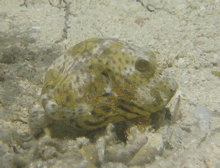
By Bob Goemans

The scientific name for the Dogface puffer is Arothron nigropunctatus. This fish exists in many different color variation and is sometimes sold asBlackspotted puffer, Striped dogface puffer or Black dogface puffer. The Dogface puffer is not recommended for aquarists without any previous saltwater experience.

Wild Dogface puffers inhabit a region that stretches from east Africa to the southern part of Japan, and just like most other marine creatures they need a stable environment to do well. You should keep the water temperature in your aquarium between 24 and 27° C (74 and 80° F) and the pH must be 8.1-8.4. An sg. in the 1.020-1.025 range is recommended.
The Dogface puffer can reach a maximal size of 33 centimeters (13 inches) and should not be kept in an aquarium smaller than 350 liters (90 gallons). If have a very large aquarium, i.e. 6000 liters (1500 gallons) or more, it is possible to house more than one Dogface puffer since each fish will be able to claim its own territory. If your aquarium is smaller than this, you should stick to one single Dogface puffer. Keeping several fishes together in a small aquarium will lead to territorial disputes that can end in severe injuries or even deaths. If you plan to keep more than one Dogface puffer in you aquarium, you should also make sure that you decorate the aquarium in a clever way. By creating natural borders you can make it easier for the fishes to claim their own territories. The aquarium decoration should always make it possible for them to stay out of each others sight. Keep a watchful eye over your puffers and ideally have another “rescue aquarium” set up where you can place one of them if the experiment turns out bad.
The fact that the Dogface puffer is highly territorial does however not mean that it must be kept alone. A Dogface puffer is usually not aggressive towards members of other fish species, and you can for instance house it together with other puffer fish species. Triggerfish, large Angelfish, big Wrasses, and some of the Tang species are other suggestions. Immature Dogface puffers are actually very docile and should not be housed with more aggressive fish, since the young Dogface puffer can refrain from eating if it feels insecure in the aquarium.
Getting your fish to eat can sometimes be a problem even with adult Dogfish puffers. If your Dogfish puffer embarks on a hunger strike, you should always check the water quality since poor water quality can make this fish loose its appetite altogether. Refraining from eating is also common in stressed or frightened puffers. It might be harassed by more aggressive species in the aquarium or kept in a tank that is very barren and offers no hiding spaces. When you introduce a Dogfish puffer to a new home it will often stop eating and must to be coaxed into accepting food again. Ideally, you should only purchase a Dogface puffer that displays a healthy appetite in the fish store. You can feed your Dogface puffer marine fish, crabs, clams, squid, shrimp and other forms of meaty marine foods.
Just like all the other puffer species, the Dogface puffer can inflate itself by sucking in water or air. In the wild, the puffer uses this ability to frighten off predators. Each time the puffer inflate itself it does however risk its own life, since it can die if air gets stuck inside it. It might look very funny when your Dogface puffer puffs up to twice its normal size, but intentionally frightening your puffer is cruel. If air gets stuck inside its body, it can die.
The Dogface puffer is a charming fish with a lot of personality. Many keepers of Dogface puffers report how they grow really attached to each fish, just as they would to a cat or a dog. Each specimen can develop its own characteristic personality and display a wide range of individual behaviors. If you are fond of keeping large cichlids due to their fascinating individualism, you will probably love the Dogface puffer.